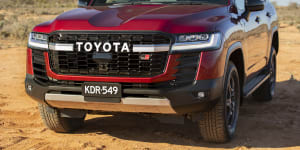The revised plan will ease the impact on some of the nation’s top-selling sports utility vehicles and set a smoother trajectory to cut carbon emissions over the next five years,in line with changes last week to a similar plan in the United States.

The ministers agreed to reclassify models such as the Toyota LandCruiser as light commercial vehicles.Supplied
But an exclusive survey highlights the challenge for the federal government in winning voter support for the reform,with 31 per cent of voters saying authorities should leave it to car makers to produce cleaner cars over time.
The Resolve Political Monitor shows 43 per cent of voters opposed the when asked about the policy in its original form,while 22 per cent supported the plan and 35 per cent were unsure.
Energy Minister Chris Bowen and Transport Minister Catherine King unveiled the modified plan on Tuesday with four changes that would help ute and SUV manufacturers after they warned they would have to lift prices or withdraw models from the market.
The ministers agreed to reclassify models such as the Toyota LandCruiser,Ford Everest and Isuzu MU-X as light commercial vehicles,cutting the emission targets they would have to meet.

In addition,the overall targets for light commercial vehicles will be eased to recognise the changes in the US last week,when the Biden administration responded to a backlash from car makers and auto industry unions by easing the targets in the early years of the plan.
A third change will delay the start of the regime by six months so car makers do not have to meet the financial obligations until July 1 next year,although the law will apply from January 1.
A fourth change will adjust the weight limit that determines how the emission targets apply,a small shift that will help SUVs and similar vehicles. Because electric vehicles have the added weight of large batteries,this change may also help those models.
Bowen and King set out an initial plan to require car makers not to exceed 141 grams of carbon dioxide a kilometre from passenger vehicles and 199 grams from utes and vans next year across all new vehicles sold. The targets were meant to fall annually to reach 58 and 91 grams per kilometre by 2030.
The original target assumed a 61 per cent fall in carbon intensity for passenger vehicles over five years,triggering a ferocious response from industry executives who said no country had achieved that outcome. The modified plan achieves a similar target for passenger vehicles.
For light commercial vehicles,however,the revised plan achieves an emissions reduction of about 50 per cent over five years,a more modest outcome than the original figure of about 60 per cent.
The revised plan,developed by Bowen and King over the past few weeks after consultation with the industry,keeps about 80 to 90 per cent of the cuts to carbon emissions by 2050,according to government officials.
The policy is not a tax. It offers credits to cleaner vehicles such as EVs,while requiring the makers of fuel-intensive vehicles like SUVs to buy those credits or pay a penalty to the government.

While Opposition Leader Peter Dutton has called the policy a “ute tax” and warned that some vehicles could cost $25,000 more,the modelling to support that claim has sparked disputes within the Federal Chamber of Automotive Industries,the source of the estimates. Members Tesla and Polestar have,while Volkswagen has distanced itself from the claims.
Asked on Tuesday if the policy was a ute tax,Toyota Australia chief Matthew Callachor said:“No,the actual policy is directed at reducing the overall emissions in the economy.”
Motor Trades Association of Australia chief executive Matt Hobbs cautiously welcomed the government’s changes,saying “nobody gets everything they want” and the outcome reflected the US changes.
“And from my perspective,it’s a workable compromise,” he said.
Because car makers can bank credits for up to three years,Hobbs estimated they were unlikely to pay penalties in the first three years of the scheme.
The Resolve Political Monitor found that 38 per cent of voters were aware of the “New Vehicle Efficiency Standard” plan,but 62 per cent were unaware of it despite the heavy criticism of the government in parts of the media because of the industry reaction to the emission cuts.
A broader question asked voters about the goal of the federal policy and found no clear majority for change.
It found that 31 per cent of voters preferred the idea of leaving it to car makers to make their vehicles more efficient over time,while 12 per cent said the government should stick to the original fuel standards plan.

Another 18 per cent said the fuel standards should be delayed by a year or two to ensure the market was ready,while 14 per cent said it should be redesigned to make slower cuts to emissions over time.
The results have a margin of error of 2.4 percentage points.
Cut through the noise of federal politics with news,views and expert analysis from Jacqueline Maley..